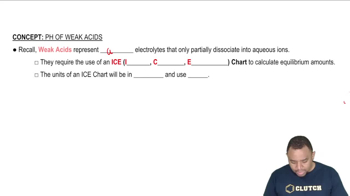Here are the essential concepts you must grasp in order to answer the question correctly.
Equilibrium Constant (K)
The equilibrium constant (K) quantifies the ratio of the concentrations of products to reactants at equilibrium for a reversible reaction. In this case, K = 1.33 indicates that at equilibrium, the concentration of H2SO3 is favored over the reactants. Understanding K helps predict how changes in conditions affect the position of equilibrium and the concentrations of species in solution.
Recommended video:
Weak Acids and Their Dissociation
Weak acids, like H2SO3, do not fully dissociate in solution, which means they establish an equilibrium between the undissociated acid and its ions. The dissociation constants (Ka1 and Ka2) provide insight into the strength of the acid and the extent of dissociation. For H2SO3, Ka1 = 1.5 * 10^-2 indicates that the first dissociation is relatively strong, while Ka2 = 6.3 * 10^-8 shows the second dissociation is much weaker.
Recommended video:
pH Calculation
pH is a measure of the hydrogen ion concentration in a solution, calculated using the formula pH = -log[H+]. In solutions of weak acids, the pH can be determined from the concentrations of the acid and its dissociated ions. For this problem, calculating the pH involves determining the equilibrium concentrations of H2SO3, HSO3-, and SO3^2- and using these to find the concentration of H+ ions.
Recommended video:
 Verified step by step guidance
Verified step by step guidance

